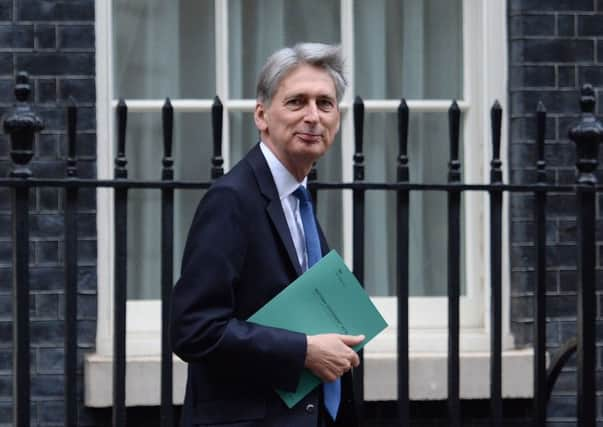Autumn Statement: Treasury faced with £56bn Brexit black hole


Philip Hammond used his first ever Autumn Statement to announce new funding for infrastructure, housing and technology schemes in a bid to increase productivity prior to leaving the EU.
Justifying the additional £26bn of Government borrowing, he stressed the need to make the economy “match fit” for the challenges ahead.
Advertisement
Hide AdAdvertisement
Hide AdBut his commitment to fiscal responsibility was dealt a blow by the Office for Budget Responsibility, as it revealed sweeping downgrades to UK growth and a revised debt forecast of £122bn.
According to the watchdog almost half (£59bn) of this “eye-watering” funding black hole can be put down to the knock-on effects of Brexit.
The organisation warns UK trade could suffer for up to 10 years as a result of June’s vote, with accompanying dips in household income, higher inflation, and weaker exchange rates.
The gloomy prediction was accompanied by a revised GDP growth forecast for 2017, dropping from 2.2% to 1.4%.
Advertisement
Hide AdAdvertisement
Hide AdIt also slashed forecasts for 2018 and 2021, but maintained its outlook of 2.1% growth in 2019 and 2020.
The combination of increased debt and lower revenue streams has put an end to any talk of achieving a budget surplus by 2020.
But addressing the Commons yesterday, Mr Hammond assured MPs he remains committed to balancing the books “as soon as practicable”.
He announced a new draft Charter for Budget Responsibility, with targets to reduce the rate of borrowing by the end of this Parliament.
Advertisement
Hide AdAdvertisement
Hide AdHe also announced a welfare spending cap, to be set by Government and monitored by the OBR.
“A credible fiscal policy remains essential for maintaining market confidence and restoring the economy to long-term health,” he told MPs.
“This Autumn Statement... re-states our commitment to living within our means and sets out our choice to invest in the future.”
Headline spending pledges included a £3.7bn fund to support the construction of new homes and a £4.7bn science and innovation fund.
Advertisement
Hide AdAdvertisement
Hide AdThe Treasury will also commit £2.6bn to improve roads and tackle congestion, and £700m to support the roll-out of fibre broadband connections.
For the seventh year in a row, the Government agreed to freeze fuel duty, saving the average driver £130 a year.
And it reaffirmed its commitment to cutting corporation tax to 17% by 2020 and increasing the income tax threshold to £12,500.
However, the OBR notes that the combined value of these tax cuts is outweighed by planned increases, including a 2 percentage point rise on insurance premiums.
Advertisement
Hide AdAdvertisement
Hide AdIt also states that the impact of leaving the EU could be worse than it is currently forecasting, because it has not assumed a “bumpy” Brexit.
Responding to the Statement, Labour Shadow Chancellor John McDonnell claimed it offers “little hope for the future”.
He accused the Government of “betraying” those people who are “working hard to deliver for their families”.
“The country remains unprepared and ill-equipped to meet the challenges of Brexit and secure [its] future as a world-leading economy,” he said.
“After all the sacrifices that people have made over the last six years, I fear today’s Statement has laid the foundations for more wasted years.”